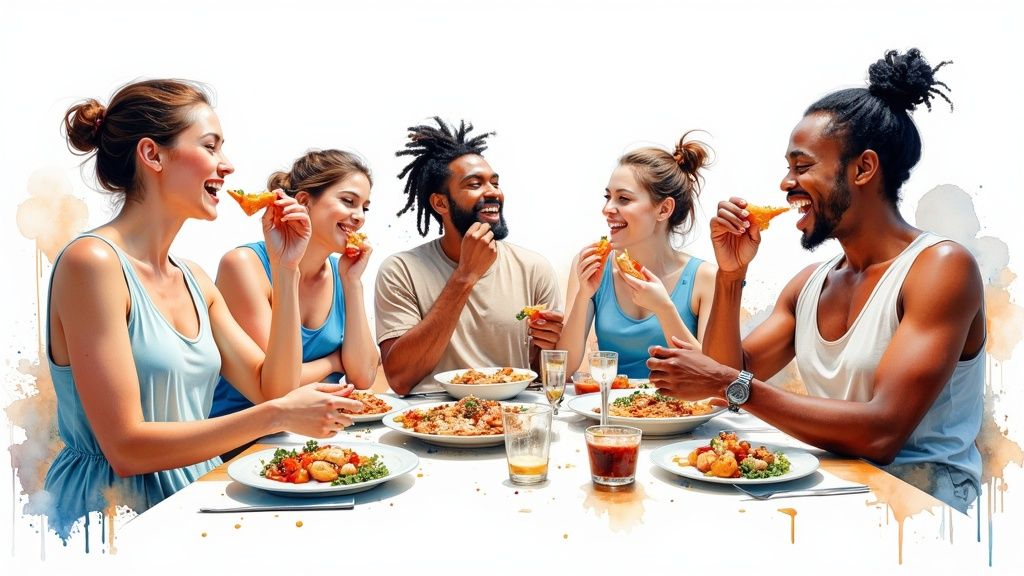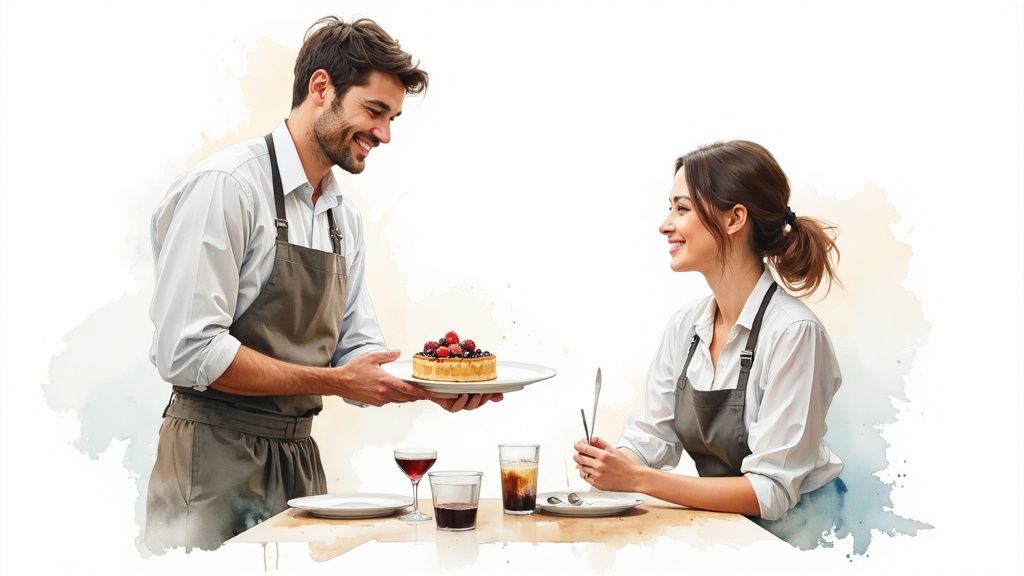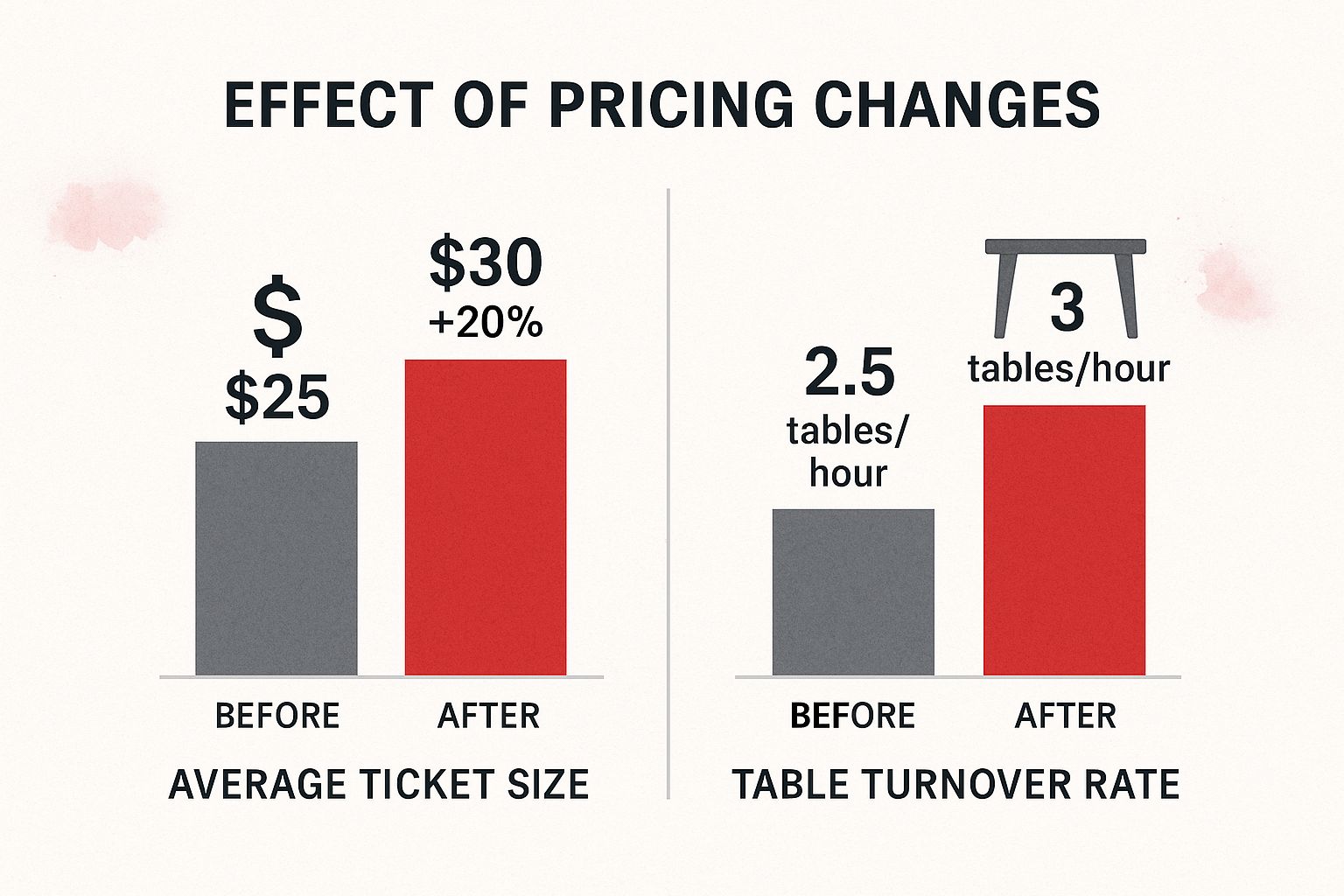Increase restaurant sales with strategies for your menu, staff, and marketing.

Trying to increase restaurant sales doesn't mean a massive overhaul. The quickest wins come from smart, targeted changes you can implement tonight by optimizing what you already have: your menu, your team, and your existing customer data.

When you're operating on thin margins, you need practical strategies that deliver results fast. This guide helps you boost orders with low-cost, high-impact actions you can start doing today.
The good news?
Over 80% of operators expect sales to hold steady or grow, presenting a huge opportunity for independents who operate smarter. For more context, you can explore these proven strategies to improve sales performance.
Your most powerful assets are already inside your four walls:
Menu 'Hot Spot' Highlighting - Place your highest-margin dish in the upper-right corner of your menu. 5-10% increase in sales for that item.
Daily Upsell Challenge - Offer a small bonus (e.g., a free coffee) to the server who sells the most featured appetizers. Boosts average check size by $1-$3 per table.
Suggestive Selling - Train staff to suggest a specific drink pairing for your top three entrees. Increases beverage sales by up to 15%.
When designed correctly, your menu can actively guide guests, bumps up check averages, and boosts profitability without your staff saying a word. This isn't about tricking guests; it's about using proven psychology to highlight your best dishes.
Before changing anything, you need to know what you’re working with. This is where your POS data and menu engineering come in. Classify every item into one of four categories:
People don’t read menus; they scan.
Research shows their eyes are drawn to specific spots first. Placing your "Stars" and "Puzzles" in these prime locations increases the odds they get ordered.
This key area is often called the "golden triangle" on a single-page menu:
Put your most profitable dishes in these zones. Use subtle visual cues like a box or an asterisk to draw more attention and make it effortless for a guest to spot the items you want to sell most.
The words you use to describe your food matter. Descriptive language can make a dish sound irresistible and justify a higher price.
Look at this simple swap:
The second description paints a picture and can increase an item's sales by up to 27%.

Good upselling isn't a hard sell; it's about making the guest’s experience better. It’s turning servers into trusted guides who make thoughtful recommendations that improve a meal. This builds trust, makes guests feel looked after, and grows your average check size.
The secret to a great upsell is genuine product knowledge. Quick, regular training sessions turn your team into an active part of your sales strategy. Use your daily pre-shift meetings—just five minutes to taste and talk about a high-margin dish. This gives servers authentic language to describe it with passion.
Focus their training on:
Consistency is the biggest hurdle with upselling. Modern POS systems like Peppr can be set up to prompt staff with smart upselling opportunities. When a server enters a steak frites, a pop-up can remind them to ask, "Would you like to add sautéed mushrooms?" This automated prompting ensures every server makes the offer every time and builds consistency into your workflow.
Keeping your team fired up is non-negotiable, especially as recent data shows a slight decline in tipping percentages, which can impact morale. Get more insights from this recent restaurant report.
A simple, friendly competition can be very effective:
These games make upselling fun and show your staff you value their effort.
Marketing for an independent restaurant must be smart and efficient. The goal is to build a steady flow of customers by focusing on practical strategies that work, especially on a slow Tuesday night.
You need a direct line to your customers. Two of the most effective ways are email and a loyalty program.
Start collecting email addresses at the host stand or on your website. A simple weekly email with specials is all it takes. For loyalty, forget complicated point systems. A simple "buy five lunches, get one free" punch card is effective because it gives new customers a tangible reason to return.
Customers look you up online before they visit. What they find on Google and Yelp is often the deciding factor.
Make sure your website is easy to find. For more, check out our guide on digital restaurant marketing. If you offer catering, strong SEO strategies for catering businesses can land you big group orders.
Third-party delivery apps can feel like a necessary evil. They offer visibility, but commission fees—sometimes hitting 30%—can gut your margins. It’s time to stop renting your customers and start owning those relationships by bringing ordering in-house.
When an order comes through a third-party app, they get the customer data. An in-house system flips that script.
With your own online ordering, you can:

Setting up a new system can be painless with a modern restaurant POS.
A platform like Peppr integrates commission-free online ordering directly into your current operations. No extra tablets, no new software to learn. Orders flow straight to your kitchen display system just like any other ticket. This seamless integration slashes errors and keeps the kitchen running smoothly. For more on this, check out these 10 must-have features in restaurant POS software.
FeatureThird-Party Delivery AppsIn-House Ordering SystemCommission FeesHigh fees, typically 15-30% per order.Zero commission fees. You keep 100% of the revenue.Customer DataThe app owns the customer data and relationships.You own all customer data for marketing and loyalty.Brand ControlYour brand is listed alongside all your competitors.You control the entire brand experience and user interface.MarketingLimited ability to market directly to customers.Direct access to customers for promotions and specials.Operational FlowOften requires a separate tablet, creating clutter and errors.Integrates directly into your POS and Kitchen Display System.
While third-party apps offer visibility, the long-term cost is steep. An in-house system is an investment in your restaurant's future, allowing you to capture growth profitably and build direct relationships that secure the financial health of your business.

You’ve got questions, and you don’t have time for fluff. Let’s get straight to the answers.
Focus on maximizing what you already have. The quickest wins are inside your four walls. Start with a quick menu optimization.
These steps cost nothing but can immediately lift your average check size by guiding spending toward your most profitable items.
Conduct a full menu engineering analysis at least twice a year, with a lighter review quarterly. This rhythm keeps your offerings fresh and aligned with your financial goals.
Don't treat your menu as a static document. Consistent analysis prevents profit leaks.
Yes, but only if you keep it simple. For an independent restaurant, a loyalty program is about driving repeat visits. It costs five times more to attract a new customer than to keep an existing one.
The key is to make the reward achievable and valuable. Forget programs where a customer has to spend hundreds to get a free coffee.
An effective program could be:
The ROI isn't just the redeemed reward; it's the habit you build. Each visit strengthens their connection to your restaurant, turning a casual diner into a loyal regular.
Ready to take control of your sales with a system built by restaurant people, for restaurant people?
Peppr integrates commission-free online ordering, powerful analytics, and staff-friendly tools to help you grow your bottom line.
Trying to increase restaurant sales doesn't mean a massive overhaul. The quickest wins come from smart, targeted changes you can implement tonight by optimizing what you already have: your menu, your team, and your existing customer data.

When you're operating on thin margins, you need practical strategies that deliver results fast. This guide helps you boost orders with low-cost, high-impact actions you can start doing today.
The good news?
Over 80% of operators expect sales to hold steady or grow, presenting a huge opportunity for independents who operate smarter. For more context, you can explore these proven strategies to improve sales performance.
Your most powerful assets are already inside your four walls:
Menu 'Hot Spot' Highlighting - Place your highest-margin dish in the upper-right corner of your menu. 5-10% increase in sales for that item.
Daily Upsell Challenge - Offer a small bonus (e.g., a free coffee) to the server who sells the most featured appetizers. Boosts average check size by $1-$3 per table.
Suggestive Selling - Train staff to suggest a specific drink pairing for your top three entrees. Increases beverage sales by up to 15%.
When designed correctly, your menu can actively guide guests, bumps up check averages, and boosts profitability without your staff saying a word. This isn't about tricking guests; it's about using proven psychology to highlight your best dishes.
Before changing anything, you need to know what you’re working with. This is where your POS data and menu engineering come in. Classify every item into one of four categories:
People don’t read menus; they scan.
Research shows their eyes are drawn to specific spots first. Placing your "Stars" and "Puzzles" in these prime locations increases the odds they get ordered.
This key area is often called the "golden triangle" on a single-page menu:
Put your most profitable dishes in these zones. Use subtle visual cues like a box or an asterisk to draw more attention and make it effortless for a guest to spot the items you want to sell most.
The words you use to describe your food matter. Descriptive language can make a dish sound irresistible and justify a higher price.
Look at this simple swap:
The second description paints a picture and can increase an item's sales by up to 27%.

Good upselling isn't a hard sell; it's about making the guest’s experience better. It’s turning servers into trusted guides who make thoughtful recommendations that improve a meal. This builds trust, makes guests feel looked after, and grows your average check size.
The secret to a great upsell is genuine product knowledge. Quick, regular training sessions turn your team into an active part of your sales strategy. Use your daily pre-shift meetings—just five minutes to taste and talk about a high-margin dish. This gives servers authentic language to describe it with passion.
Focus their training on:
Consistency is the biggest hurdle with upselling. Modern POS systems like Peppr can be set up to prompt staff with smart upselling opportunities. When a server enters a steak frites, a pop-up can remind them to ask, "Would you like to add sautéed mushrooms?" This automated prompting ensures every server makes the offer every time and builds consistency into your workflow.
Keeping your team fired up is non-negotiable, especially as recent data shows a slight decline in tipping percentages, which can impact morale. Get more insights from this recent restaurant report.
A simple, friendly competition can be very effective:
These games make upselling fun and show your staff you value their effort.
Marketing for an independent restaurant must be smart and efficient. The goal is to build a steady flow of customers by focusing on practical strategies that work, especially on a slow Tuesday night.
You need a direct line to your customers. Two of the most effective ways are email and a loyalty program.
Start collecting email addresses at the host stand or on your website. A simple weekly email with specials is all it takes. For loyalty, forget complicated point systems. A simple "buy five lunches, get one free" punch card is effective because it gives new customers a tangible reason to return.
Customers look you up online before they visit. What they find on Google and Yelp is often the deciding factor.
Make sure your website is easy to find. For more, check out our guide on digital restaurant marketing. If you offer catering, strong SEO strategies for catering businesses can land you big group orders.
Third-party delivery apps can feel like a necessary evil. They offer visibility, but commission fees—sometimes hitting 30%—can gut your margins. It’s time to stop renting your customers and start owning those relationships by bringing ordering in-house.
When an order comes through a third-party app, they get the customer data. An in-house system flips that script.
With your own online ordering, you can:

Setting up a new system can be painless with a modern restaurant POS.
A platform like Peppr integrates commission-free online ordering directly into your current operations. No extra tablets, no new software to learn. Orders flow straight to your kitchen display system just like any other ticket. This seamless integration slashes errors and keeps the kitchen running smoothly. For more on this, check out these 10 must-have features in restaurant POS software.
FeatureThird-Party Delivery AppsIn-House Ordering SystemCommission FeesHigh fees, typically 15-30% per order.Zero commission fees. You keep 100% of the revenue.Customer DataThe app owns the customer data and relationships.You own all customer data for marketing and loyalty.Brand ControlYour brand is listed alongside all your competitors.You control the entire brand experience and user interface.MarketingLimited ability to market directly to customers.Direct access to customers for promotions and specials.Operational FlowOften requires a separate tablet, creating clutter and errors.Integrates directly into your POS and Kitchen Display System.
While third-party apps offer visibility, the long-term cost is steep. An in-house system is an investment in your restaurant's future, allowing you to capture growth profitably and build direct relationships that secure the financial health of your business.

You’ve got questions, and you don’t have time for fluff. Let’s get straight to the answers.
Focus on maximizing what you already have. The quickest wins are inside your four walls. Start with a quick menu optimization.
These steps cost nothing but can immediately lift your average check size by guiding spending toward your most profitable items.
Conduct a full menu engineering analysis at least twice a year, with a lighter review quarterly. This rhythm keeps your offerings fresh and aligned with your financial goals.
Don't treat your menu as a static document. Consistent analysis prevents profit leaks.
Yes, but only if you keep it simple. For an independent restaurant, a loyalty program is about driving repeat visits. It costs five times more to attract a new customer than to keep an existing one.
The key is to make the reward achievable and valuable. Forget programs where a customer has to spend hundreds to get a free coffee.
An effective program could be:
The ROI isn't just the redeemed reward; it's the habit you build. Each visit strengthens their connection to your restaurant, turning a casual diner into a loyal regular.
Ready to take control of your sales with a system built by restaurant people, for restaurant people?
Peppr integrates commission-free online ordering, powerful analytics, and staff-friendly tools to help you grow your bottom line.
